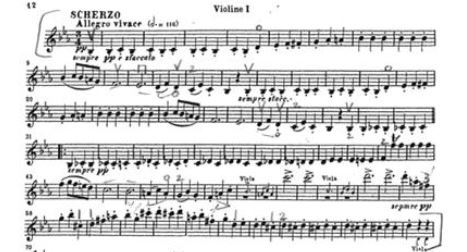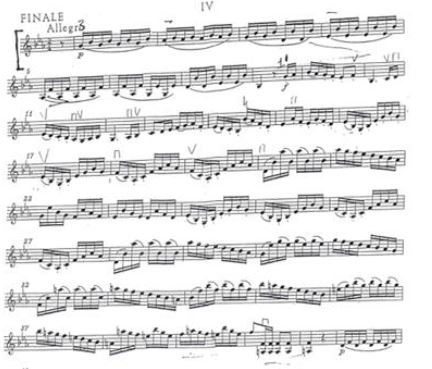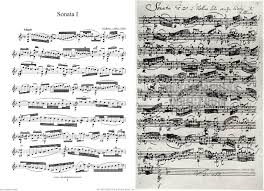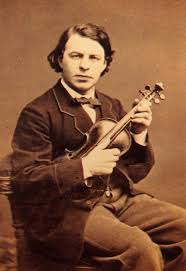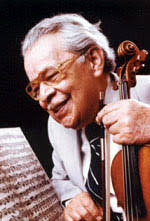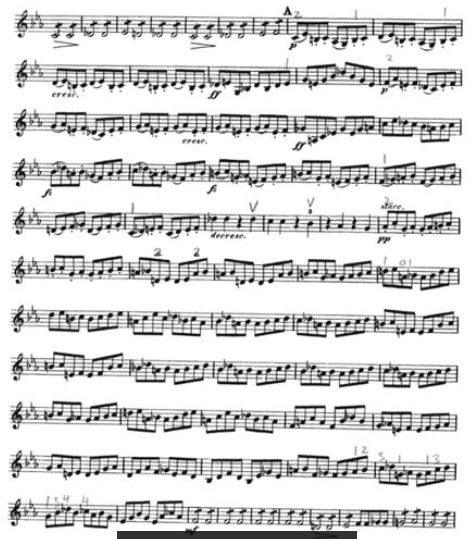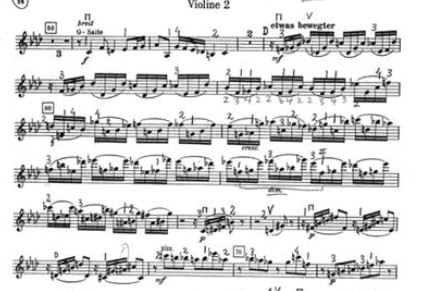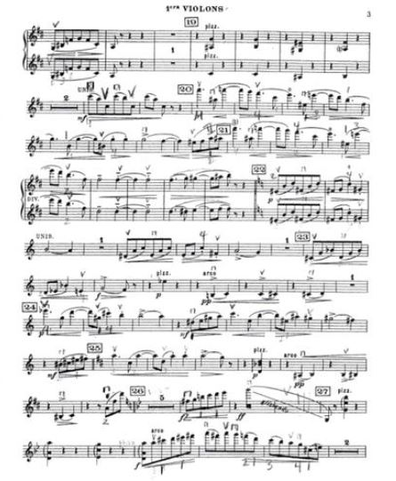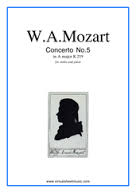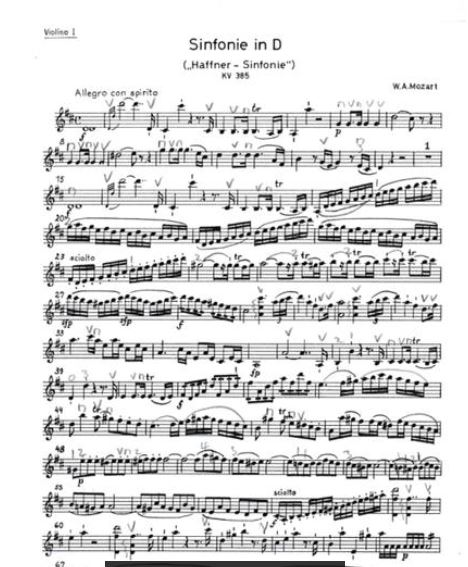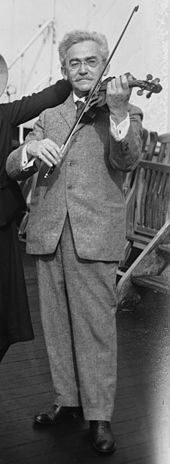2. AUDITION REPERTOIRE
“If you really know Mozart operas, you will play Mozart orchestral excerpts much better”[1]
In the following chapter I shall discuss the most often required repertoire for tutti violin audition. I will give examples of the orchestral excerpts one could expect for first and second violin auditions, which I have edited with what I consider good bowings and fingerings. Tips on how to prepare the repertoire will be discussed in the chapter “How to prepare effectively for an audition."
Concerti
Jokingly, it could be said that once you have completed your studies at the Conservatoire and have obtained your Bachelor’s or Master’s Degree, the only repertoire you really need is the first movement of a Mozart Concerto (preferably KV219), a romantic concerto and a long list of orchestral excerpts. This is of course incredibly short-sighted, but the truth is that this is probably what you need the most as far as repertoire goes, to secure a job in a good orchestra as it is common practice for violinists to be asked to play a Mozart Concerto together with a romantic concerto at an audition.
Some orchestras are very specific about the concertos they wish to hear. In The Netherlands, many orchestras have had a free choice for the Mozart Concerto as long as it is KV216, KV218 or KV219. There is a shift in this policy now as some orchestras will only accept KV219.[2] Bearing this in mind, it would be a good idea to have studied and performed this concerto often during your student days. Generally it is the first movement that is required, although occasionally the slow movement will also be requested. This will be clearly indicated in the requirements.[3]
As far as the romantic concerto is concerned, some orchestras are very limited as to which concerto they will accept. This will surely be listed in the advertisement, but one should make sure to have studied Sibelius, Tchaikovsky or the Brahms Concerto. As a student, it will be of invaluable help to have already performed your concerti often once you start to take part in auditions. It is also true that many orchestras also accept other concertos such as Mendelssohn, Beethoven, Dvorak, Glazunov, eventually Prokofiev, Bartók Violin Concerto No.2, Khachaturian and Shostakovich. Generally orchestras will ask you which romantic concerto you have chosen on the application form. Then, you will hear from the orchestra in question if the concerto you have chosen is acceptable. If you are not sure, it is better to check ahead of time. The best would be to choose a romantic concerto that is widely accepted.
When it comes to choosing a cadenza for a Mozart Concerto, many orchestras will specify which cadenza they wish to hear. When this is not specified, it would be wise to ask the orchestra which cadenza they would like. Although some orchestras are very happy and charmed to hear an original cadenza, most orchestras still stick to the Joachim cadenzas for KV218 and KV219 and the Sam Franko cadenza for KV216.[4] Be prepared to play the cadenza even if the orchestra has not specified the cadenza and have only asked for the first movement. The same applies if the orchestra asks for the second movement. Asking for the movement implies the inclusion of the cadenza.
The same applies for the romantic concerto. If the orchestra asks for the first movement of the concerto, prepare the entire movement, including the cadenza. It is always dangerous to second-guess a committee and the jury will be unforgiving if you play the exposition wonderfully but have not prepared the rest.
Bach
Many orchestras also include Bach in their choice of repertoire for the audition. Perhaps stylistically, this is the most tricky part of the audition. Everyone has their own strong opinion about how Bach should be played. Listening to recordings of the orchestra for which you are applying will give you a few answers as to the style for which the orchestra is looking. The best solution will be to play very convincingly with your own choices about style and articulation.
Chamber Music
Occasionally one will be asked to take part in the performance of some chamber music at an audition as some orchestras see this as an ideal way to assess a candidate’s flexibility. The chamber music repertoire will most likely be announced ahead of time. Advice on how to prepare for this eventual part of the audition is discussed in the next chapter. The chamber music will be performed with members of the orchestra for which you are applying.
Sight-reading
Although including sight-reading at an audition was common practice some years ago, it is now rarely included in the repertoire of an audition. However, occasionally one is asked to sight-read a few excerpts at an audition. Preparation for this should be ongoing. This means that sight-reading is in any case a very valuable tool to have in your grasp. It would be a valuable part of your practising to include some sight- reading regularly. There has been quite a lot of research performed on possibilities of developing good sight-reading practices and what this could mean for your overall development.[5] If you choose orchestral excerpts to be the repertoire for sight-reading in your regular practicing, then it is easy to log on to the website www.imslp.org and choose any movement of a large portion of the orchestral repertoire.[6] Like this, if you are lucky, you will have played through the part before when it is presented as sight-reading at an audition. “Being a good sight-reader is of invaluable help as an orchestral violinist”.[7] Having a head start on first readings of orchestral literature will help you immensely in your preparation time.
Orchestral excerpts
There are many books of orchestral excerpts, an extensive list of which can be found in my bibliography.
I shall discuss a few of the more commonly used excerpt books.
Orchester Probespiel-Test Pieces for Orchestral Auditions[8]
This book contains some of the most commonly asked excerpts, but some of the excerpts are too short to be used effectively. Unfortunately, the layout of the book is quite bad and one has to turn pages often in the middle of an excerpt.
There is also a series of books with orchestral excerpts edited by Gingold.[9] “Orchestral Excerpts from the Symphonic Repertoire.” Although these books were published initially in 1953, they are still useful. Many of the excerpts are too short compared to what is usually asked at auditions, but the books are very useful to practise sight-reading. In the same series, there are two volumes of “Orchestral Excerpts from Operas and Concert Works” edited by R. Kuenzel.
There are two volumes of orchestral excerpts for violin by Strauss.[10] These are helpful, but once again the excerpts are quite short.
Most of the excerpts most commonly asked by orchestras are incomplete in these books. There have not been many new books published recently as it is possible to find most of the music online.[11] There are, however, a few issues with the music to be found online.
The first issue is the occasional occurrence of actual mistakes in the parts. If one is not familiar enough with the music, it is almost impossible to detect the mistakes. Even if you listen to the music, it is sometimes difficult to pick out the misprints. Also, there are no bowings or fingerings in the parts found online. Although it is sometimes helpful to have a clean part, it is more helpful I think to have suggestions for bowings and fingerings.
One can find additional parts as mentioned previously online, but also from the site www.orchestraexcerpts.com.
Additional parts can be seen at www.archives.nyphil.org. This is a very interesting site to look at, as many of the parts are from Bernstein’s time with the orchestra. One is allowed to study the parts, but they are not meant for public use.
Considering the fact that there are issues with the excerpt books as previously mentioned and the music found online, I have chosen to include an extensive list of the most commonly required parts for first and second violin tutti auditions. Every orchestra has their own favorite list of orchestral excerpts required at auditions.[12] If the orchestra sends you the parts with bowings, it is good practice to play the parts as presented. The excerpt list appears in this chapter. In the following chapter the excerpt list is repeated with links to the sheet music which I have marked myself with bowings and fingerings. There is also a direct link to an audio fragment corresponding to the excerpt.
The sheet music itself has come from an online site[13], my own music library, or from the library at the Residentie Orkest, to which I have access as a member of the orchestra.
I have tried as much as possible to use Urtext[14] editions.
FIRST VIOLIN EXCERPTS
|
COMPOSER |
WORK |
MOVEMENT |
Measure (m.), Letter (L.) or number (No.) |
|
Bartók, B. |
Concerto for Orchestra (1943) |
l. Introduzione-Andante non troppo V. Finale |
m.51-94
m.277-317 |
|
|
Divertimento (1919) |
1. Allegro non troppo |
m.1-32 |
|
Beethoven, L.von |
Symphony No.1 in C major, Op.21 (1800) |
lV. Adagio-Allegro molto e vivace |
m.1-78 |
|
|
Symphony No.3 in Eb major, Op.55 (1804) |
lll. Scherzo |
m.1-68 |
|
|
Symphony No.4 in Bb major, Op.60 (1806) |
lV. Allegro ma non troppo |
m.1-118
|
|
|
Symphony No.9 in D minor, Op.125 (1824) |
ll. Scherzo lll. Adagio molto e cantabile |
m.9-85 m.99-115 |
|
|
Leonore Overture No.3, Op.72b (1805) |
|
m.514-539 |
|
Berlioz, H. |
Symphonie Fantastique (1830) |
l. Réveries-Passions lV. The Procession to the Stake |
m.17-24 m.135-154 |
|
Bizet, G. |
Symphony in C (1855) |
ll. Andante-Adagio lV. Finale Allegro vivace |
No.3-5 m.5-no.2 |
|
Brahms, J. |
Symphony No.1 in C minor, Op.68 (1876) |
l. Un poco sostenuto lV. Adagio Allegro non troppo |
m.1-29 m.21-28 m.1-132 |
|
|
Symphony No.2 in D major, Op.73 (1877) |
l. Allegro non troppo |
m.17-66 m.118-156 |
|
|
Symphony No.3 in F major, Op.90 (1883) |
l. Allegro con brio |
m.1-B
|
|
|
Symphony No.4 in E minor, Op.98 (1885) |
lll. Allegro Giocoso lV. Allegro energico e passionate |
m.1-63 m.33-81 |
|
Bruckner, A. |
Symphony No.9 in D minor (1896) |
lll. Trio V. lV. Adagio |
m.158-262 m.1-7
|
|
Debussy, C. |
La Mer (1905) |
ll. Jeux de Vagues |
No.19-20 No.35-39 |
|
Glinka, M. |
Overture to Ruslan and Ludmilla (1842) |
|
m.1-5 bars before B |
|
Haydn, J. |
Symphony No.94 in G major (1791) |
lV. Finale |
m.1-74 |
|
|
Symphony No.83 in G minor (1791) |
lV. Finale |
m.1-35 |
|
Mahler, G. |
Symphony No.1 in D major (1888) |
l. Langsam
ll. Kräftig bewegt lV. Stürmisch bewegt |
No.5 to 8 bars before No.8 No.8-No.11 No.16-No.18 |
|
|
Symphony No.4 in G major (1900) |
lll. Ruhevoll, poco adagio |
5 bars after No.2 to 11 bars after No.3 |
|
|
Symphony No.5 (1902) |
lV. Adagietto |
m.2-34 |
|
|
Symphony No.9 (1909) |
lV. Adagio |
m.1-12 |
|
Mendelssohn, F. |
Midsummer Night’s Dream Op.61 (1842) |
Overture Scherzo |
m.8-39 m.17-7 bars after D |
|
|
Symphony No.4 in A major, Op.90 (1833) |
l. Allegro vivace |
m.1-110 |
|
Mozart, W.A. |
Overture Magic Flute K.620 (1791) |
Allegro |
m.5-48 |
|
|
Overture The Marriage of Figaro K.492 (1786) |
Presto |
m.1 to A |
|
|
Overture Don Giovanni K.527 (1782) |
|
m.32-76 |
|
|
Overture The Abduction from the Seraglio K.384 (1782) |
|
m.1-63 |
|
|
Symphony No.29 in A major K.201 (1774) |
l. Allegro moderato |
m.1-77 |
|
|
Symphony No.35 in D major K.385 (1782) |
l. Allegro con spirit V. Presto |
m.1-66 m.1-80 |
|
|
Symphony No. 39 in Eb major K.543 (1788) |
lV. Allegro |
m.1-41 |
|
|
Symphony No. 41 in C major K.551 (1788) |
lV. Allegro molto |
m.1-94 |
|
Prokofiev, S. |
Romeo and Juliet Op.64 (1939) |
6. The Fight 10. Juliet as a Young Girl 13. Dance of the Knights |
No.26-30 No.50-53 m.3 to 5 bars after No.79 |
|
Ravel, M. |
La Valse (1920) |
|
2 bars before No.20 to 7 bars after No.27 |
|
|
Daphnis et Chloé, Second Suite (1912) |
|
No.161-166 No.212-217
|
|
Rossini, G. |
Overture La Gazza Ladra (1817) |
|
Allegro to C |
|
Schönberg, A. |
Verklärte Nacht (1899) |
|
m.159-181 |
|
Schubert, F. |
Symphony No.2 in Bb major (1815) |
l. Allegro vivace |
m.1-48
|
|
|
Symphony No.5 in Bb major (1816) |
l. Allegro |
m.1-92
|
|
Schumann, R. |
Symphony Nr.2 in C major Op.61 (1846) |
ll. Scherzo |
m.1-55 |
|
Shostakovich, D. |
Symphony No.5 in D minor Op.47 (1937) |
l. Moderato-Allegro non troppo |
m.1-32 m.217-246 |
|
Sibelius, J. |
Symphony No.2 in D major Op.43 (1902) |
lll. Vivacissimo |
22 bars after H to 9 bars after J |
|
Strauss, R. |
Don Juan Op.20(1888) |
|
First page |
|
|
Also Sprach Zarathustra Op.30 (1896) |
|
No.3-No.7 |
|
Stravinsky, I. |
Rite of Spring (1913) |
l. Danses des adolescents |
No.33 for 16 bars |
|
|
Apollon Musagète (1928) |
|
Coda |
|
|
Concerto in D (1946) |
lll. Rondo |
No.72-1 bar before No.78 |
|
Tchaikovsky, P.I. |
Symphony No.6 in B minor Op.74 (1893) |
lll. Allegro molto vivace
|
m.1-15 |
|
|
Nutcracker Suite Op.71a (1892) |
Overture |
m.57-106 |
|
Weber, C. M. von |
Overture Oberon (1826) |
Allegro con fuoco |
m.1-50 |
SECOND VIOLIN EXCERPTS
|
COMPOSER |
WORK |
MOVEMENT |
MEASURE(M.) OR LETTER OR NUMBER(NO.) |
|
Bartók, B. |
Concerto for Orchestra (1943) |
V. Finale |
No.267-317 |
|
Beethoven, L.von |
Symphony Nr.3 in Eb major, Op.55 (1804) |
Scherzo |
m.1-70 |
|
|
Symphony Nr.6 in F major, Op.68 (1808) |
lV. Donner, Sturm, Allegro |
m.3-20 |
|
|
Symphony Nr.9 in D minor, Op.125 (1824) |
ll. Molto vivace |
m.9-85
|
|
Berlioz, H. |
Symphonie Fantastique (1830) |
lV. The Procession to the Stake |
m.135-154 |
|
Brahms, J. |
Symphony Nr.1 in C minor, Op.68 (1855-1876) |
lV. Adagio |
m.22-28 |
|
|
Piano Concerto Nr.1 in D minor, Op.15 (1858) |
Finale |
m.238-264 |
|
Bruckner, A. |
Symphony Nr.9 in D minor (1896) |
Finale |
m.57-65 m.129-139 |
|
Elgar, E. |
Enigma Variations Op.36 (1899) |
ll. Allegro |
No.5-8 |
|
Mahler, G. |
Symphony Nr.4 in Gmajor (1900) |
lll. Ruhevoll(Poco adagio) |
m.17 to 7 bars after No.1 |
|
|
Symphony Nr.9 (1909) |
lV. Adagio |
M.1-11 |
|
Mendelssohn, F. |
Midsummer Night’s Dream Op.61 (1842) |
Scherzo |
m.17-D |
|
Mozart, W.A. |
Overture The Magic Flute K.620 (1791) |
Allegro |
m.16-59 |
|
|
Symphony Nr.39 in Eb major K.543(1788) |
Finale |
m.1-42 |
|
|
Symphony Nr.41 in C major K.551 (1788) |
lV. Molto Allegro |
m.1-36 |
|
Prokofiev, S. |
Classical Symphony in D major, Op.25 (1917) |
Finale |
F-K |
|
Rachmaninoff, S. |
Symphony Nr.2 in E minor,Op.27 (1907) |
ll. Meno Mosso |
No.32-35 |
|
Ravel, M. |
Daphnis et Chloé, 2nd Suite (1912) |
|
No.197-199 |
|
Schonberg, A. |
Verklärte Nacht (1899) |
|
No.251-270 |
|
Schubert, F. |
Symphony Nr.4 in C minor (1816) |
lV. Finale |
A-B |
|
Shostakovich, D. |
Symphony Nr.5 in D minor, Op.47 (1937) |
lll. Largo, third violin part Second violin part |
m.1-No.78
No.94-96 |
|
Strauss, R. |
Don Juan, Op.20 (1888) |
|
First page |
|
|
Ein Heldenleben, Op.40 (1898) |
|
No.94 to 3 bars after No.97 |
|
|
Also Sprach Zarathustra, Op.30 (1896) |
|
5 bars after No.14 to 8 bars after No.17 |
|
Stravinsky, I. |
Concerto in D (1946) |
lll. Rondo |
m.1 to 2 bars before No.81 |
|
|
Symphony in 3 Movements (1945) |
lll. Con moto |
No.185 to 194 |
|
|
Apollon Musagète (1928) |
Coda |
Coda to No.86 |
This is a very extensive list, but it covers the excerpts frequently requested at orchestras throughout the world.
[1] Interview with Noah Bendix-Balgley, First Concertmaster of the Berlin Philharmonic www.auditioncare.org accessed 25-3-2017
[3] As an example, see here audition requirements from The New York Philharmonic and The Netherlands Chamber Orchestra (see attachment)
[4] Joseph Joachim (1831-1907) was a German violinist, composer and violin pedagogue. The Joachim cadenzas are included in the Bärenreiter editions of the Mozart Concertos. Sam Franko (1857-1937) was an American violinist and conductor. The Sam Franko cadenza can be found in the Schirmer Edition of Mozart Concerto KV216
[5] Kageyama, N. http://www.bulletproofmusician.com/are-great-sight-readers-born-or-made/ accessed 4-5-2017
[6]www.imslp.org This website contains sheet music of much of the musical literature accessed almost daily
[9] Josef Gingold (1909-1995) Russian-born violinist and influential American violin teacher www.nytimes.com accessed 4-2-2017
[11]www.imslp.org accessed almost daily
[13]www.imslp.org accessed almost daily
[14] Urtext. An urtext edition is a version intended to reproduce the original intention of the composer, without added or changed material. https://en.wikipedia.org/wiki/Urtext_edition accessed 4-2-2017
